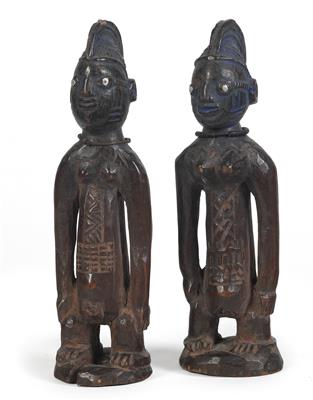Yoruba, Nigeria: a pair of ‘ibeji’ twin figures, female and male. A very rare type: Ilesha.
Yoruba, Nigeria: a pair of ‘ibeji’ twin figures, female and male. A very rare type: Ilesha.

Among the Yoruba people twins are regarded as something special. They are honoured in a separate cult and are considered to bring good fortune and blessing to their family. Another peculiarity: the Yoruba believe that twins only have one soul between them. That means that if one twin were to die, the surviving twin would only have half a soul. Therefore a ‘vicarious figure’ of wood is carved for him (or her). This guarantees that the soul is complete again. These small wooden figures are called ‘ibeji’. They are treated as if they were a living twin. ‘Ibeji figures’ are washed, fed, embraced, sung to, they receive sacrificial offerings and are honoured on domestic altars. Overtime, throughout the entire Yoruba settlement area in Southwest Nigeria, many different styles of carving ‘ibeji figures’ have evolved, differing from town to town and region to region.
The present pair of ‘ibeji’ twin figures are female and male. Both old pieces originate from the same carver and are crafted from hard wood. They have relatively small heads, tall crested coiffures and aluminium pins in their eyes as pupils. They have long bodies and arms and they stand on short legs, on a round base plate carved out from the same piece of wood. Both heads show traces of a blue colouring (‘bluing’) and both bodies bear remains of sacrificial offerings with redwood powder. Both ‘ibeji’ are wearing necklaces made from small, black beads. There are two small cracks, one on the head of the male figure and one on the base plate of the female ‘ibeji’, as well as a good, old shiny patina on both figures due to years of use. Another peculiarity of this ‘ibeji pair’ is their unusually opulent, decorative scarification marks grooved on their heads and bodies: on the temples and cheeks as well as on the chests, abdomens and backs, front and back. The marks are extensive zigzag lines, as well as patterns of short, straight lines and hatched patterns. It is a very rare stylistic type, perhaps from a carver’s workshop in the town of Ilesha. Height: each 24.5 cm; first half of the 20th century. (ME)
Provenance:
Austrian private collection.
Lit.:
'Enzyklopädie der Ibeji' by Fausto Polo, ill. 319, 321.
Specialist: Erwin Melchardt
 Erwin Melchardt
Erwin Melchardt
+43-1-515 60-465
erwin.melchardt@dorotheum.at
09.06.2016 - 17:00
- Starting bid:
-
EUR 1,000.-
Yoruba, Nigeria: a pair of ‘ibeji’ twin figures, female and male. A very rare type: Ilesha.
Among the Yoruba people twins are regarded as something special. They are honoured in a separate cult and are considered to bring good fortune and blessing to their family. Another peculiarity: the Yoruba believe that twins only have one soul between them. That means that if one twin were to die, the surviving twin would only have half a soul. Therefore a ‘vicarious figure’ of wood is carved for him (or her). This guarantees that the soul is complete again. These small wooden figures are called ‘ibeji’. They are treated as if they were a living twin. ‘Ibeji figures’ are washed, fed, embraced, sung to, they receive sacrificial offerings and are honoured on domestic altars. Overtime, throughout the entire Yoruba settlement area in Southwest Nigeria, many different styles of carving ‘ibeji figures’ have evolved, differing from town to town and region to region.
The present pair of ‘ibeji’ twin figures are female and male. Both old pieces originate from the same carver and are crafted from hard wood. They have relatively small heads, tall crested coiffures and aluminium pins in their eyes as pupils. They have long bodies and arms and they stand on short legs, on a round base plate carved out from the same piece of wood. Both heads show traces of a blue colouring (‘bluing’) and both bodies bear remains of sacrificial offerings with redwood powder. Both ‘ibeji’ are wearing necklaces made from small, black beads. There are two small cracks, one on the head of the male figure and one on the base plate of the female ‘ibeji’, as well as a good, old shiny patina on both figures due to years of use. Another peculiarity of this ‘ibeji pair’ is their unusually opulent, decorative scarification marks grooved on their heads and bodies: on the temples and cheeks as well as on the chests, abdomens and backs, front and back. The marks are extensive zigzag lines, as well as patterns of short, straight lines and hatched patterns. It is a very rare stylistic type, perhaps from a carver’s workshop in the town of Ilesha. Height: each 24.5 cm; first half of the 20th century. (ME)
Provenance:
Austrian private collection.
Lit.:
'Enzyklopädie der Ibeji' by Fausto Polo, ill. 319, 321.
Specialist: Erwin Melchardt
 Erwin Melchardt
Erwin Melchardt
+43-1-515 60-465
erwin.melchardt@dorotheum.at
|
Buyers hotline
Mon.-Fri.: 10.00am - 5.00pm
kundendienst@dorotheum.at +43 1 515 60 200 |
| Auction: | Tribal Art - Africa |
| Auction type: | Saleroom auction |
| Date: | 09.06.2016 - 17:00 |
| Location: | Vienna | Palais Dorotheum |
| Exhibition: | 04.06. - 09.06.2016 |
